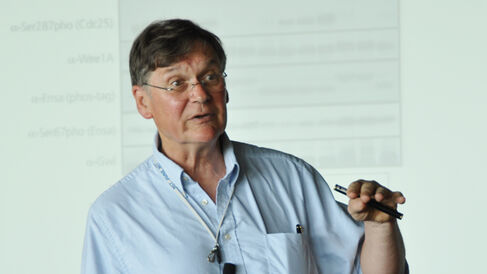Tim Hunt

Nobel Prize in Physiology or Medicine 2001 for discoveries of key regulators of the cell cycle, shared with Leland Hartwell and Sir Paul Nurse.
Department of Biochemistry PhD student (1964-1968, PhD awarded 1968), Postdoctoral Researcher (1971-1976) and Research Group Leader (1977-1990).
Tim Hunt read Natural Sciences at Cambridge and became a research student in the Department of Biochemistry in 1964 under the direction of Asher Korner. He spent a few months in Irving London's laboratory in New York, whence he returned after completing his PhD in 1968 to work on protein synthesis in the rabbit reticulocyte system. He continued this interest when he came back to work with Tony Hunter and Richard Jackson in the Department of Biochemistry in Cambridge, where he remained until 1990 when he moved to the Cancer Research UK London Research Institute (now part of the Francis Crick Institute).
It became Hunt's habit to spend summers at the Marine Biological Laboratory at Woods Hole, Massachusetts where the ready supply of surf clams and sea urchins was much appreciated by those interested in protein synthesis during embryogenesis and mitosis. In the summer of 1982, having added [35S]-methionine to a suspension of fertilised sea urchin eggs and removed samples at intervals for gel electrophoresis, Hunt noticed that the autoradiogram "showed something very odd and unexpected", namely that, although most of the protein bands got stronger and stronger as time went by, one band did not show this expected behaviour. It was prominent at the beginning of the experiment but at a certain point it faded away. He concluded that this protein underwent specific proteolysis at some point in the early development of the fertilised egg. Thus were the cyclins discovered.
Hunt went on to show that cyclins begin to be synthesised after egg fertilisation, then increase in levels during interphase and decline very quickly in mitosis during every round of cell division. Cyclins are present in vertebrate cells and Hunt and others showed that they bind and activate a family of protein kinases, now called the cyclin-dependent kinases, one of which had been identified as a crucial cell cycle regulator by Paul Nurse. Beginning in 1976, Nurse had identified the gene cdc2 in fission yeast (Schizosaccharomyces pombe) as controlling the progression of the cell cycle from G1 phase to S phase and the transition from G2 phase to mitosis. In 1987, Nurse identified the homologous human gene, CDK1, a cyclin-dependent kinase. Also working in yeast, Leland Hartwell identified the fundamental role of checkpoints in cell cycle control and the importance of genes such as cdc28, which controls the start of the cycle; the progression through G1 phase.
For resolving the mechanisms by which the cell cycle is controlled, Tim Hunt shared the 2001 Nobel Prize in Physiology or Medicine with Leland Hartwell and Paul Nurse.
